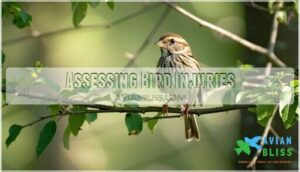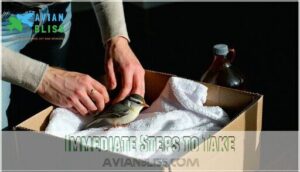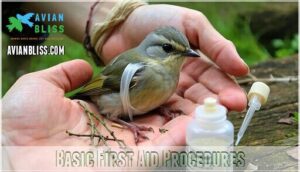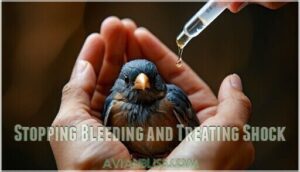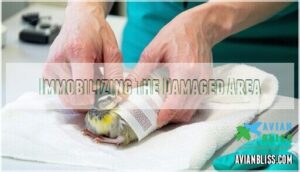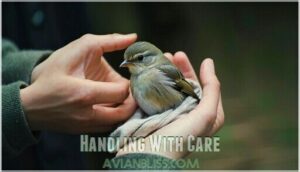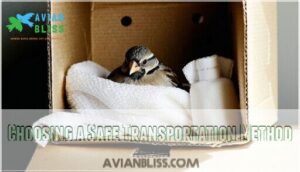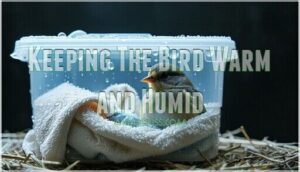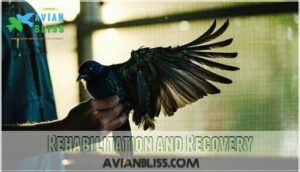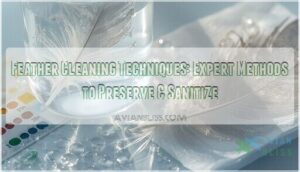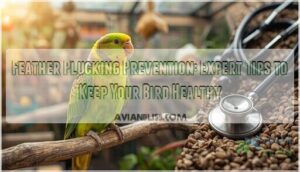This site is supported by our readers. We may earn a commission, at no cost to you, if you purchase through links.
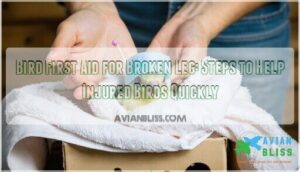
Use a soft towel to gently wrap the bird, leaving the head exposed for breathing.
Check for any bleeding and stop it with light pressure using gauze.
Immobilize the leg with a small splint—like a trimmed cotton swab—and secure it gently with veterinary tape, avoiding tightness that could cut circulation.
Keep the bird warm and quiet in a small box with ventilation and soft padding.
Transport it to an avian vet as soon as possible for proper care.
Quick action makes a big difference!
Table Of Contents
- Key Takeaways
- Assessing Bird Injuries
- Providing First Aid
- Transporting The Bird
- Seeking Veterinary Care
- Rehabilitation and Recovery
- Frequently Asked Questions (FAQs)
- How do I help a bird with a broken leg?
- Can a bird’s broken leg heal on its own?
- What is the immediate first aid for a broken leg?
- Can a bird’s wound heal on its own?
- Can you do anything for a bird with a broken leg?
- How do you treat a broken bone in a bird?
- How do you help a bird with a broken?
- How do I comfort a stressed bird?
- What are signs of shock in birds?
- Can I use human painkillers for birds?
- Conclusion
Key Takeaways
- Secure the bird in a small, dark, ventilated container lined with soft materials to minimize stress and movement.
- Gently immobilize the broken leg using a soft splint or tape, being careful not to restrict circulation.
- Keep the bird warm and calm while monitoring for signs of shock like irregular breathing or lethargy.
- Transport the bird to an avian vet as quickly as possible for appropriate treatment and care.
Assessing Bird Injuries
When evaluating a bird’s injuries, start by observing its posture, movement, and behavior for signs of distress.
Look closely for visible abnormalities like swelling, unusual angles, or the inability to use a leg, which can be a clear sign of injuries.
Recognizing Signs of a Broken Leg
Spotting a bird leg fracture quickly can save its life.
Act fast—a bird leg fracture identified early can mean the difference between recovery and life-threatening complications.
Watch for these signs:
- Weight Bearing: The bird avoids putting weight on one leg.
- Leg Angulation: The leg looks bent oddly.
- Palpable Fractures: Gently feel for unusual bumps.
- Feather Appearance: Fluffed-out feathers signal distress.
- Posture Changes: Awkward sitting or balancing means trouble.
Recognize these signs to act fast! Birds may also exhibit signs of a sprain, which requires prompt attention.
Identifying The Severity of The Injury
After you’ve spotted signs of a leg injury, you’ll need to assess its severity.
Check for fracture type by looking for abnormal angles in the limb. Perform a mobility check – a bird with a broken leg won’t put weight on it.
Look for swelling signs around the injury site and examine for open wounds that might indicate a compound fracture.
Pain assessment is essential – the bird may appear stressed or vocalize when the area is approached.
Visually Examining The Bird
During your visual examination, observe the bird’s overall posture and leg angulation without touching it.
Check for awkward positioning, drooping wings, or reluctance to stand. Note feather condition around the leg area for blood or discoloration.
Examine the eyes for alertness and equal pupil size. Watch breathing patterns—labored breathing may indicate shock.
This initial bird first aid assessment helps determine the severity of a bird leg injury.
Physically Examining The Bird
After your visual check, it’s time to gently handle the bird for a closer examination.
With clean hands, carefully support the bird’s body while checking its breathing pattern. Examine the eyes for brightness and equal pupil size.
Notice feather condition and overall posture. When evaluating leg movement, look for unnatural angles or swelling.
Gently palpate the injured area, feeling for abnormalities without applying pressure. Remember, bird first aid requires a delicate touch to avoid additional stress.
Providing First Aid
You’ll need to act quickly when providing first aid to a bird with a broken leg, focusing first on minimizing stress and preventing further injury.
Act swiftly to provide first aid; reducing stress and stabilizing the injured leg can significantly improve a bird’s chance of recovery.
After securing the bird in a dark, quiet container, you can carefully assess the damage and gently immobilize the leg using materials like micropore tape while avoiding restricting its breathing or causing additional pain.
Immediate Steps to Take
Now that you’ve identified an injured bird, taking immediate action is critical.
Safety first—both yours and the bird’s.
Here’s what to do right away:
- Place the bird in a dark, quiet box lined with soft towels
- Keep handling to an absolute minimum to prevent stress
- If there’s bleeding, apply gentle pressure with clean cloth
- Maintain warmth with a covered hot water bottle nearby
Remember, birds hide illness well—quick action improves survival chances substantially.
Basic First Aid Procedures
Now that you’ve secured the injured bird, it’s time to apply proper first aid.
For a broken leg, gently immobilize the damaged area using small sticks as makeshift splints with light bandaging.
Keep handling techniques minimal to reduce stress.
Check for additional wounds that may need cleaning. Styptic powder is essential for stopping any bleeding.
Offer sweetened water for hydration and shock management.
Pain relief can be administered through baby-strength Calpol based on the bird’s size.
Stopping Bleeding and Treating Shock
After providing basic first aid, you’ll need to address any bleeding and shock before handling the broken leg.
To stop bleeding:
- Apply direct pressure with clean gauze for 5 minutes
- Use styptic powder or flour to help form clots
- Avoid removing existing blood clots
After using direct pressure, consider using specialized clotting products for birds.
Place your bird in a warm (25-30°C), semi-dark environment to treat shock.
Minimize handling to reduce stress and offer sweetened water for hydration.
Monitor for shock symptoms like weakness and rapid breathing.
Immobilizing The Damaged Area
Once bleeding is controlled, you’ll need to immobilize the broken leg to prevent further injury.
This step is critical before transport to a veterinarian. A proper bird leg splint can aid in the healing process.
Here’s a quick guide to temporary bird leg immobilization techniques:
| Method | Materials Needed | Best For | Time Limit |
|---|---|---|---|
| Tape splint | Hypoallergenic tape | Small/medium birds | 24 hours |
| Paper towel wrap | Clean paper towels + tape | Emergency situations | 12 hours |
| Cage confinement | Small, padded container | All injured birds | During transport |
| Towel donut | Rolled towel | Birds in shock | 2-3 hours |
The techniques include using a tape splint, paper towel wrap, cage confinement, or a towel donut, each suitable for different situations and time limits.
Transporting The Bird
You’ll need to transport the injured bird quickly but carefully to prevent further damage to its broken leg.
Place the bird in a small, ventilated container lined with soft towels to keep it warm and secure during the journey to veterinary care.
Handling With Care
Now that you’ve provided first aid, proper handling is critical. When dealing with a bird broken leg, use a gentle approach.
Cup the bird lightly in your hands, avoiding direct pressure on the injury. A secure grip prevents escape while minimizing trauma.
Wrap a soft cloth around the bird to reduce stress, keeping wings close to its body. Remember to prioritize minimizing stress and trauma during this process.
Never hold by just the feet or wings – this could worsen the injury and cause unnecessary pain.
Choosing a Safe Transportation Method
A cardboard box can be a lifesaving vessel for transporting injured birds with broken legs.
Choose the right carrier to guarantee safe delivery to veterinary care:
- Select a secure container with air holes (box or paper bag for small birds)
- Line with towels or carpet to prevent slipping and additional trauma
- Include a heat source like a wrapped hot water bottle for temperature control
- Cover three sides with a towel to minimize visual stimuli and stress
For specialized needs, consider using a suitable bird carrier.
Reducing Stress During Transport
Stress can magnify a bird’s injury during transport.
Keep the carrier covered with a lightweight cloth to create a quiet environment. Minimize handling and avoid sudden movements or loud noises.
Place the carrier on a stable surface in your vehicle, away from air vents. Soft, gentle talking provides reassurance while maintaining a calm atmosphere.
These bird safety measures substantially improve recovery chances during emergency care.
Keeping The Bird Warm and Humid
Maintain ideal temperature control for an injured bird by creating a warm environment of 25-30°C (77-86°F).
You’ll need to wrap a hot water bottle in cloth and place it near the bird’s container for consistent warmth.
Proper humidity levels help prevent shock during transport, and keeping the environment semi-dark and quiet to reduce stress is also crucial.
This supportive care is vital for bird emergency care, especially when treating leg fractures.
Seeking Veterinary Care
You’ll need to take your injured bird to an avian veterinarian as soon as you’ve stabilized it for transport.
Professional medical care is essential for proper diagnosis and treatment of leg fractures, which often require specialized techniques like radiography and proper splinting to guarantee complete healing.
Locating an Avian Veterinarian
Finding an avian veterinarian quickly is vital when dealing with a bird’s broken leg. Not all vets treat birds effectively.
- Search online directories specifically for "avian veterinarians" or "emergency avian vets"
- Call local emergency clinics to confirm they handle bird emergency care
- Check vet qualifications—look for specialized training in avian medicine
- Ask for local recommendations from bird clubs or pet stores
Costs for avian vet care typically range higher than regular vet visits.
Preparing for The Veterinary Visit
Now that you’ve found an avian vet, you’ll need to prepare properly for your visit.
Call ahead and provide details about your feathered patient’s condition to help the vet prepare for bird fracture repair.
| Preparation Step | Why It Matters | What To Do | Benefit |
|---|---|---|---|
| Medical history | Speeds diagnosis | List symptoms and timing | Faster treatment plan |
| Transport setup | Reduces stress | Use dark, warm container | Prevents worsening injury |
| Pain observation | Guides treatment | Note behavior changes | Appropriate bird pain relief |
| Financial planning | Avoids delays | Ask about costs upfront | No surprises at checkout |
Remember to bring any medications your bird takes regularly to guarantee proper stabilize bird leg techniques.
Understanding Treatment Options
Several treatment options exist for birds with broken legs, depending on the injury’s severity.
Your avian vet will likely recommend one of these approaches:
- Splinting techniques using hypoallergenic tape for simple fractures
- Surgical intervention with specialized fixation for complex breaks
- Medication management including pain relief and antibiotics
X-rays are essential for accurate diagnosis before any bird leg cast application.
For severe cases, avian fracture repair might require temporary immobilization to prevent further damage during healing.
Rehabilitation and Recovery Process
The rehabilitation journey for a bird with a broken leg involves several critical phases.
After your vet’s treatment, you’ll need to monitor the healing process closely.
Splint removal typically occurs after about a month, followed by a gentle exercise regimen to rebuild strength.
During recovery, provide nutritional support with calcium supplements and observe for behavioral changes.
Bird rehabilitation success depends on proper care, appropriate leg support, and patience throughout the mobility restoration process.
Rehabilitation and Recovery
You’ll need to monitor your bird’s healing progress carefully throughout the rehabilitation period, which typically ranges from three to six weeks depending on the fracture’s severity.
During recovery, you’ll provide proper nutrition, limited activity, and possibly gentle physical therapy to help your feathered patient regain strength and mobility.
Rehabilitation Timelines
After your vet visit, you’ll need patience for the bird’s recovery journey.
The avian bone healing process typically spans 4-6 weeks for simple fractures, while complex breaks may require 8-12 weeks.
During splint duration, factors like bird size, age, and nutrition substantially impact healing speed.
Smaller birds heal faster than larger species.
Most birds achieve full recovery within 3 months when provided proper long-term care throughout their rehabilitation.
Implementing Rehabilitation Exercises
Once the healing process starts, focus on range-of-motion and muscle strengthening.
Encourage coordination exercises using perch training with different diameters.
Gradually help with flight reintroduction to rebuild strength.
For bird leg rehabilitation, guarantee safe, steady surfaces to promote avian bone healing.
Always monitor for progress—small steps in bird recovery tips lead to big gains in balance and mobility.
Caring for a Convalescing Bird
Once exercises are underway, focus on creating comfort and safety. A proper cage environment aids recovery.
- Use soft bedding for bird leg support, preventing re-injury.
- Nutrition strategies like calcium-rich foods bolster bird health.
- Limit social interaction but monitor progress daily for swelling or stress.
Providing a quiet space can minimize stress and trauma.
These bird care steps guarantee smooth recovery and better overall bird first aid outcomes.
Preventing Complications and Promoting Healing
Check the splint daily for fit and cleanliness to prevent discomfort or infection.
Limit the bird’s movement using a small, quiet space to encourage proper healing. Offer a balanced diet, as nutrition’s role is key to recovery.
Watch for swelling or changes in behavior, which may signal issues needing attention. Regularly monitoring healing guarantees effective bird leg support.
Frequently Asked Questions (FAQs)
How do I help a bird with a broken leg?
Imagine you’re helping a fragile treasure.
Gently secure the bird in a small, dark container to reduce stress.
Immobilize the leg with tape or a splint, and seek an avian vet promptly for proper care.
Can a bird’s broken leg heal on its own?
A bird’s broken leg might heal on its own, but improper alignment often causes lasting problems.
Without intervention, the bone may not heal correctly, leading to chronic pain or mobility issues.
Always consult an avian vet.
What is the immediate first aid for a broken leg?
Keep the injured limb still by gently immobilizing it with clean, soft materials.
Place the bird in a quiet, dark space to reduce stress.
Treat shock using warmth and seek veterinary care as soon as possible.
Can a bird’s wound heal on its own?
Wounds aren’t magic—they need care to heal properly.
While birds might recover minor injuries alone, untreated wounds can lead to infections or complications.
Always clean, monitor, and, if unsure, consult a vet to guarantee proper healing.
Can you do anything for a bird with a broken leg?
You can help by gently immobilizing the leg with soft tape, keeping the bird in a small, quiet space to limit movement.
Comfort it with warmth, and contact an avian vet as soon as possible.
How do you treat a broken bone in a bird?
To treat a bird’s broken bone, stabilize it first.
Use soft tape for splinting, immobilize joints above and below the fracture, and keep movement minimal.
Placing it in a quiet, dark space prevents stress.
How do you help a bird with a broken?
Picture a delicate twig snapping in the wind—handle the bird gently to avoid causing stress.
Immobilize its leg with a soft splint or tape, keep it warm and calm, and contact a vet promptly.
How do I comfort a stressed bird?
Create a calm, quiet space with dim lighting.
Speak softly, move slowly, and avoid sudden noises.
Gently offer favorite treats or a cozy perch. Reduce stressors to help the bird feel safer and relaxed.
What are signs of shock in birds?
Signs of shock in birds include irregular or strained breathing, fluffed feathers, lethargy, weakness, and a faint or unresponsive appearance.
You might notice the bird staying still, possibly crouched, as it struggles to conserve energy.
The bird’s overall demeanor, including lethargy, can indicate its struggle to cope with shock.
Can I use human painkillers for birds?
You’d think human painkillers like aspirin are helpful, but they’re dangerous for birds.
Medications like ibuprofen can cause toxicity.
Stick to avian-safe options like Meloxicam, prescribed by a vet, to avoid harming your feathered friend.
Conclusion
Around 45% of injured birds survive with proper first aid and care, highlighting the importance of quick intervention.
By learning bird first aid for broken legs, you can make a critical difference in an injured bird’s recovery.
Secure the bird gently, stop any bleeding, and carefully immobilize its leg. Keep it warm, calm, and safe during transport to an avian vet.
These small, precise actions can save a life and set the bird on a path to full recovery.

